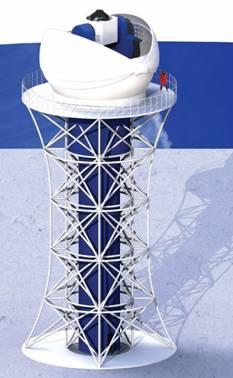 |
| Steady gaze. KDUST would sit above Dome A's thin layer of turbulent air. (CREDIT: COURTESY OF NANJING INSTITUTE OF ASTRONOMICAL OPTICS AND TECHNOLOGY) |
The 2.5-meter Kunlun Dark Universe Telescope, or KDUST, would survey the optical and near-infrared bands for planets beyond our solar system and plumb the mysteries of dark matter and dark energy. However, one instrument would be lonely, says astronomer Yang Ji , director of Nanjing s Purple Mountain Observatory, which is developing a companion: a 5-meter terahertz (THz) telescope to observe 200- to 350-micrometer wavelengths.
This underexplored frequency window"is acutely sensitive to gas clouds ideal for probing, for example, star and planet formation, says Qizhou Zhang, an astrophysicistat the Harvard-Smithsonian Center for Astrophysics in Cambridge, Massachusetts, and a member of the group that initiated the THz telescope project.
Outside experts are impressed. It s a very ambitious and exciting program, says John Storey, an astronomer at the University of New South Wales (UNSW) in Sydney, Australia.
The Chinese Academy of Sciences has requested 1 billion yuan ($150 million) for the telescopes and support platform one of several science megafacilities that the country s powerful National Development and Reform Commission is weighing for the 12th 5-year plan. A decision is expected around year s end.
The two telescopes would be a major expansion of China s formidable Antarctic buildup. During the 2007 08 International Polar Year, China erected Kunlun Station, teamed with the United States and others to study the Gamburtsev Mountains the origin of the East Antarctic ice sheet and with Australia began testing observing conditions at Dome A. To pave the way for expansion, China last year built an ice runway at Kunlun; until now, all materials and people have been brought in by arduous traverses.
China is not making a leap into the unknown. Antarctic astronomy first made headlines in 1998, when BOOMERANG, a U.S. National Science Foundation (NSF) sponsored balloon experiment, mapped the cosmic microwave background and found that the universe is fl at. As an encore, a 10-meter telescope at the U.S. Amundsen-Scott South Pole Station brought online in 2007 has begun microwave background studies. South Pole shows it is possible to build major astronomical facilities in Antarctica, says Storey.
Plenty more is in the works. The coming austral summer at the South Pole should see completion of IceCube, the biggest neutrino observatory in the world. Then next year, the NSF-funded South Pole Ultraviolet Pathfi nder will lay the groundwork for mapping the cosmic web, the universe s scaffolding of dark matter.
Also next year, U.S.-led teams plan to field two experiments the Stratospheric Terahertz Observatory balloon to be launched from McMurdo Station, and the High Elevation Antarctic Terahertz telescope, a 0.5-meter instrument to be installed at Ridge A in East Antarctica. And a six nation consortium has proposed a 2.
5-meter optical-infrared telescope for Dome C, where the French-Italian Concordia station has conducted extensive site testing.
The numerous efforts underscore the fabulous observing conditions on the plateau. Frigid temperatures make for a low infrared background, and aerosol concentrations are 1/50 of those at temperate sites. Water vapor is a bane for submillimeter and THz observations. Compared with one of the best sites in temperate latitudes Mauna Kea in Hawaii Dome A is a factor of 10 drier, says Storey. That s a staggering advantage.
Indeed, the view from Dome A may be unbeatable. This is a totally different ballgame from other astronomical sites, says UNSW s Michael Ashley. In January 2008, Chinese astronomers deployed PLATO, a suite of site-characterization instruments, at Dome A. It confirmed not only that Dome A surpasses other plateau outposts, says Ashley, but also that sometimes the view rivals Hubble. And the boundary layer of turbulent air at Dome A is only about 14 meters thick, compared with 200 meters at the South Pole, making it far cheaper to perch telescopes above Dome A.
Chinese astronomers won t have to wait for a decision on the megaproject proposal to start ramping up at Dome A. Funding is set for installation next year of the Antarctic Schmidt Telescopes, a trio of 50-centimeter telescopes that should detect at least one Earth-sized extrasolar planet per year and supernova explosions within half an hour after they become visible, says Lifan Wang, an astronomer at Texas A&M University in College Station and director of the Chinese Center for Antarctic Astronomy. This will help us study explosion mechanisms, he says.
Meanwhile, plans are in full swing for KDUST, designed by the Nanjing Institute of Astronomical Optics and Technology, and the 5-meter THz telescope. The latter has a hard act to follow: Europe s year-old Herschel Space Observatory, which has opened up a new field for terahertz astronomy, Zhang says.
But Herschel has a 3-year design life, and it s very difficult to get time on it, he says. The 5-meter at Dome A will continue discovery that Herschel started. It s also a steppingstone to a 15-meter THz telescope China hopes to build in Antarctica after 2015. Likewise, KDUST is a prelude to a 6- to 8-meter optical and near-infrared telescope.
Long before those huge telescopes become reality, however, Chinese researchers will have put Dome A on the astronomy map. (Science)
Related News
Photos
More>>trade
- Speeding up Electrons in Solar Cells
- IVPP Research Ranks among Discover Magazine's Top 100 Science Stories of 2010
- Advances of Cranial Morphology of Silurian Sarcopterygian Guiyu Oneiros
- IHEP and FECO Sign Framework Agreement on Mercury Technology Cooperation
- First Single-fingered Dinosaur Found in Inner Mongolia, China





